Keywords
oral biofilm, diet, ketogenic, vegan, paleo
Select the category the research project fits.
Life Sciences
Is this submission part of ICaP/PW (Introductory Composition at Purdue/Professional Writing)?
No
Abstract
The purpose of this study was to investigate the association between three lifestyle diets (ketogenic, vegan, and paleo) and dental biofilm formation in vitro. This study was set up in glass test tubes containing hydroxyapatite discs, an artificial saliva and 5 percent natural saliva combination, Streptococcus mutans, and Lactobacillus acidophilus. Food items from three meals (breakfast, lunch, and dinner) were selected for each diet, blended to form a consistent mixture, and added to 25 percent final volume in the test tubes. Biofilms were grown for 48, 60, and 72 hours. Biofilm density was measured quantitatively using a crystal violet assay. Cell number was determined using a vortexing-sonication-vortexing method to remove biofilm cells from the discs, followed by plating. Preliminary results show biofilm formation on the hydroxyapatite discs was significantly higher for both methods compared to a control, which contained saliva combination, Ketogenic diet mixture, and no organisms. For the zero-time control, where the discs were briefly immersed in a bacterial culture and then plated, there were no colonies present on the plates. When comparing biofilm formation on the walls of glass tubes to formation on the discs using a crystal violet assay, the discs had a higher absorbance, indicating a denser biofilm, and justifying use of the discs. These preliminary results suggest that hydroxyapatite discs are sufficient substrates for biofilm formation. The zero-time control demonstrates only biofilm cells, not planktonic cells, are being measured. It can also be concluded that the growth medium is suitable for growth of the biofilms.
Recommended Citation
Kelly, Kynnedy, "Association Between Ketogenic, Vegan, and Paleo Diets and Dental Biofilm Formation In Vitro" (2019). Purdue Undergraduate Research Conference. 20.
https://docs.lib.purdue.edu/purc/2019/Posters/20
Association Between Ketogenic, Vegan, and Paleo Diets and Dental Biofilm Formation In Vitro
The purpose of this study was to investigate the association between three lifestyle diets (ketogenic, vegan, and paleo) and dental biofilm formation in vitro. This study was set up in glass test tubes containing hydroxyapatite discs, an artificial saliva and 5 percent natural saliva combination, Streptococcus mutans, and Lactobacillus acidophilus. Food items from three meals (breakfast, lunch, and dinner) were selected for each diet, blended to form a consistent mixture, and added to 25 percent final volume in the test tubes. Biofilms were grown for 48, 60, and 72 hours. Biofilm density was measured quantitatively using a crystal violet assay. Cell number was determined using a vortexing-sonication-vortexing method to remove biofilm cells from the discs, followed by plating. Preliminary results show biofilm formation on the hydroxyapatite discs was significantly higher for both methods compared to a control, which contained saliva combination, Ketogenic diet mixture, and no organisms. For the zero-time control, where the discs were briefly immersed in a bacterial culture and then plated, there were no colonies present on the plates. When comparing biofilm formation on the walls of glass tubes to formation on the discs using a crystal violet assay, the discs had a higher absorbance, indicating a denser biofilm, and justifying use of the discs. These preliminary results suggest that hydroxyapatite discs are sufficient substrates for biofilm formation. The zero-time control demonstrates only biofilm cells, not planktonic cells, are being measured. It can also be concluded that the growth medium is suitable for growth of the biofilms.

